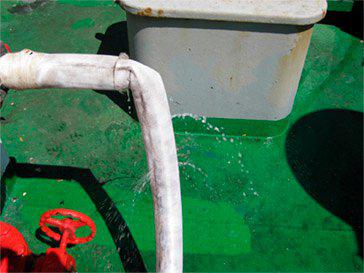Your fire hose is the connecting link in water-based non-sprinkler fire suppression systems. No matter how much water pressure your pump provides, or what pattern of coverage your nozzle delivers, if your fire hose fails, the fire is free to burn unchecked.
It is easy to see that the fire department hoses can be subject to a lot of abuse, but what about those hoses in your building? On-premise fire hoses in commercial or other publicly-occupied buildings are usually stored on hose reels, racks or in hose cabinets. Like any hose, they are subject to both physical damage and age-related failure. Just as your garden hose can fail due to internal and external abrasion, or develop a hole or weak area due to aging of the material, your fire hose can lose its structural integrity and be unable to do its job.

Does your fire hose look like this? It is time to replace.
Typically, modern types of fire hoses are required to be hydrostatically pressure tested. Since 1981, the use of unlined (linen) fire hose has been discontinued for new installations, per OSHA 1910.58, as this type of hose cannot be tested. These tests are usually conducted by a municipal fire safety agency, either directly under the auspices of the appropriate government entity, or under contract to an approved testing contractor.
The National Fire Protection Association (NFPA) does indicate guidelines for testing, but not a firm guideline on useful life. NFPA 25, Chapter 6, table 6.1.1.2 states that fire hoses should be tested every 5/3 years, and they should be pressure-tested annually, in accordance with NFPA 1962, Care, Use, Inspection, Service Testing, and Replacement of Fire Hose, Couplings, Nozzles, and Fire Hose Appliances revised in 2013. Inspection is also required after use in a fire event. NFPA 4 is a proposed guidance section that has not yet been formally adopted and is still in the comment stage, but suggestions of adopting ten-year life span guidance have been proposed.
At present, so long as your hoses pass inspection, there is no maximum life span, but common sense tells us that their materials will degrade over time. If you see obvious signs of wear in the folded or coiled areas, or where the hose connects to the fittings, it is time to consider replacement of the hose. When contrasted with the cost of replacing facilities and even a loss of life, the cost of replacing your hoses is truly insignificant.
Quick Response Fire Supply LLC offers a selection of competitively priced lightweight rack/reel lined hose, industrial single jacket, double jacket, or rubber covered fire hose, supply or attack hose for fire departments, and general-purpose non-collapsible rubber hose with working pressure ratings from 125 to 400 psi, depending on the product. When tested against imported hose, our Superior Fire Hose Corporation products offered significantly better abrasion resistance resulting in lower lifetime replacement costs and longer usable life. For even longer hose life, consider adding Superior Steadfast Coating. Quick Response Fire Supply LLC also offers discount pricing for larger orders.


What is the shelf life of Low pressure hose pipe?
NFPA code does not provide specific guidance on the shelf life – hose and hose pipes will age differently based on environmental factors and usage. Your hose should be pressure-tested annually, with a full inspection of the hose, couplings, nozzles, and appliances on a regular basis. You can work with your local authority having jurisdiction to provide you with more information.
Maximum life of hose pipe ?
10, 15, 20
As noted, NFPA code does not provide specific guidance on the maximum life of hose or pipes – hose and hose pipes will age differently based on environmental factors and usage. Regular inspections and testing will determine if the hose or pipes need to be replaced. You can work with your local authority having jurisdiction to provide you with more information.
Does shortening a 100’ section by 3-4’ of 5” supply line violate any NFPA standards on fire hose?
Michael — For specific codes and standards questions like yours, you can try our Ask a Fire Pro service. Click the link to submit your question with some information about your building, and a fire protection professional will provide an answer based on best practices, standards, and codes. Our pros include AHJs, contractors, engineers, and code experts with 150+ years of combined experience!